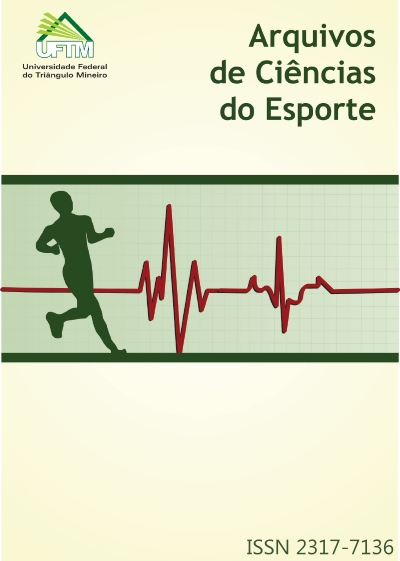Efeito imediato da auto liberação miofascial sobre a flexibilidade de jovens atletas
Palavras-chave:
auto liberação miofascial, flexibilidade, atletasResumo
Objetivo: Analisar o efeito imediato da Auto Liberação Miofascial (ALM) no desempenho da flexibilidade de adolescentes atletas. Métodos: Participaram do estudo 24 atletas do sexo masculino praticantes de futsal, handebol e voleibol. Os atletas realizaram o teste de sentar e alcançar pré e pós ALM. Para a realização da ALM foi utilizada uma bola de tênis sobre os músculos da região posterior do tronco, com estímulo sobre a musculatura específica de 30 segundos em duas séries. Foi utilizada a estatística descritiva e o teste T Student pareado para observar as diferenças pré e pós ALM para a flexibilidade, adotando um nível de significância de p<0,05. Resultados: Os resultados mostraram ganhos de 13,9% e diferença significativa para o desempenho da flexibilidade após a utilização da ALM (pré: 36,5 ± 7,04 - pós: 41,6* ± 6,46). Conclusão: Pode-se concluir que a ALM foi capaz de interferir de forma aguda no aumento da flexibilidade dos jovens atletas, indicando ser uma alternativa eficiente para a melhora dessa capacidade neuromuscular, podendo ser utilizada nas rotinas de aquecimento em treinamentos e competições no desporto coletivo.
Referências
Sullivan KM, Silvey DB, Button DC, Behm DG. Roller-massager application to the hamstrings increases sit-and-reach range of motion within five to ten seconds without performance impairments. Int J Sports Phys Ther. 2013;8(3):228–236.
Findley TW. Fascia research. third international fascia research congress. Int J Ther Massage Bodywork. 2010; 3(4):1-4.
Beardsley C, Skarabot J. Effects of self-myofascial release: A systematic review. Journal of Bodywork & Movement Therapies. 2015; 1(2): 747-758.
Cheatham SW, Kolber MJ, Cain M, Lee M. The effects of self-myofascial release using a foam roll or roller massager on joint range of motion, muscle recovery, and performance: a systematic review. The International Journal of Sports Physical Therapy. 2015;10(6):827-838.
Costa, NA, Dal Poggetto, SF. Pedroni CR. O Efeito da manipulação miofascial sobre o limiar doloroso em atletas durante período competitivo.Ter Man. 2012; 10(50):486-490.
Okamoto T, Masuhara M, Ikuta K. Acute effects of self-myofascial release using a foam roller on arterial function. J Strength Cond Res. 2014; 28 (1): 69–73.
MacDonald G, Button DC, Drinkwater E, Behm DG. Foam rolling as a recovery tool after an intense bout of physical activity. Med Sci Sports Exerc. 2014; 46(1):131–142.
Halperin I, Aboodarda SJ, Button DC, Andersen LL, Behm DG. Roller massager improves range of motion of plantar flexor muscles without subsequent decreases in force parameters. The International Journal of Sports Physical Therapy. 2014; 9 (1):1-11.
Kelly S, Beardsley C. Specific and cross-over effects of foam rolling on ankle dorsiflexion range of motion. The International Journal of Sports Physical. 2016;11(4):544-551.
Murray AM, Jones TW, Horobeanu C, Turner AP, Sproule J. Sixty seconds of foam rolling does not affect functional flexibility or change muscle temperature in adolescent athletes. Int J Sports Phys Ther. 2016;11(5):765-776.
Grieve R, Goodwin F, Alfaki M, Bourton AJ, Jeffries C, Scott H. The immediate effect of bilateral self myofascial release on the plantar surface of the feet on hamstring and lumbar spine flexibility: a pilot randomised controlled trial. J. Bodyw. Mov. Ther. 2015;19(1):544-552.
Carvalho, LS,Araújo VA. Souza ES,Santos RMC, Mendonça WV,Arruda JRL,Santa Cruz RAR. Auto liberação miofascial x alongamento estático: efeitos sobre a flexibilidade de escolares. Revista CPAQV. 2017;9(2):1-8.
Roylance DS, George JD, Hammer AM, Rencher N, Fellingham GW, Hager RL, Myrer WJ. Evaluating acute changes in joint range-of-motion using self-myofascial release, postural alignment exercises, and static stretches. Int. J. Exerc. Sci. 2013; 6: 310-319.
Bertolla F, Baroni BM, Leal Junior ECP, Oltramari JD. Efeito de um programa de treinamento utilizando o método Pilates® na flexibilidade de atletas juvenis de futsal. Rev Bras Med Esporte. 2007;13: 222-226.
DeBruyne DM, Dewhurst MM, Fischer KM, Wojtanowski MS, Dural C. Self-Mobilization Using a Foam Roller Versus a Roller-Massager: Which is More Effective for Increasing Hamstrings Flexibility? J Sport Rehabil. 2016; 24:1-20.
Skarabot J,Beardsley C, Stirn C. Comparing the effects of self-myofascial release with static stretching on ankle range-of-motion in adolescent athletes. The International Journal of Sports Physical Therapy. 2015;10(2): 203-212.
Downloads
Publicado
Edição
Seção
Licença
Deverá ser encaminhado, no momento da submissão, em documentos suplementares, as declarações de transferência de direitos autorais, responsabilidade e conflito de interesse. As declarações deverão ser elaboradas em documento único, conforme modelo disponibilizado aqui, e assinada pelo autor principal do manuscrito representando cada um dos autores.


